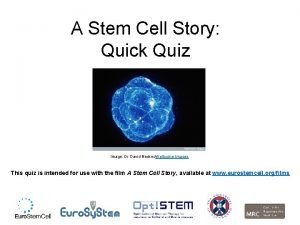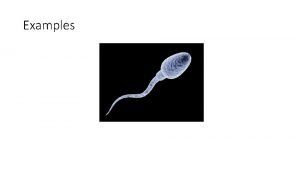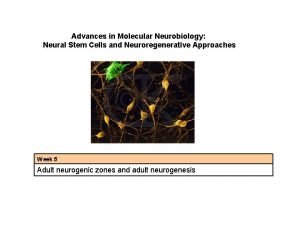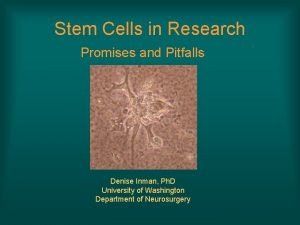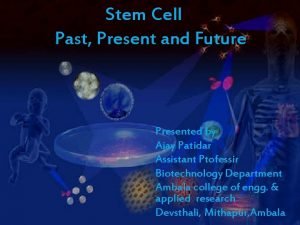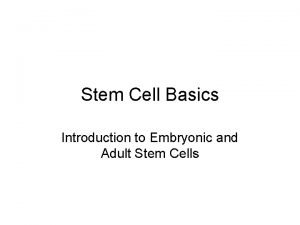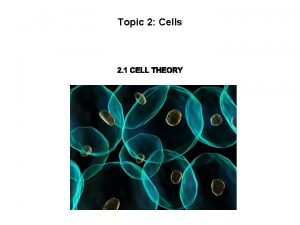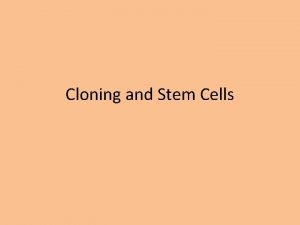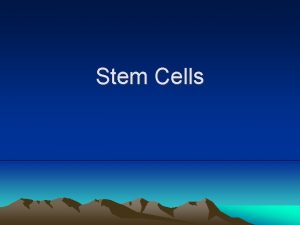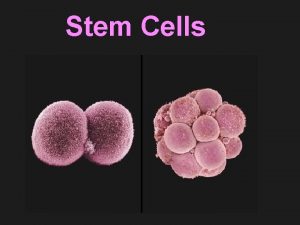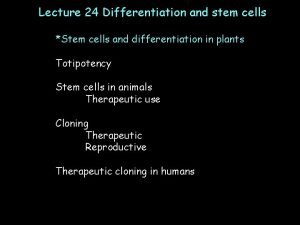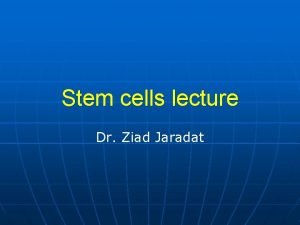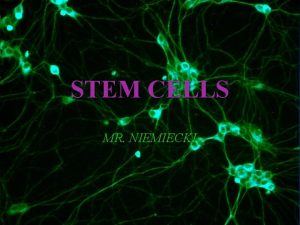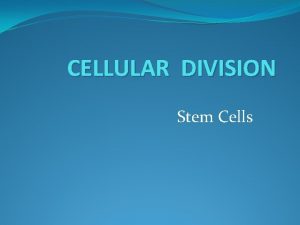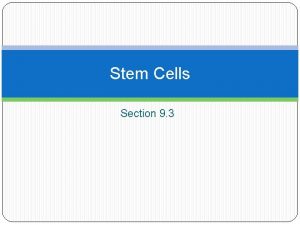Stem Cells Chapter 21 What are stem cells















- Slides: 15

Stem Cells Chapter 21

What are stem cells • These are cells which have not terminally differentiated yet • There are many types in our bodies – Some appeared early and are now no longer there – Other appeared later and some are there even today • The earliest stem cell is the fertilized egg itself - it can grow into every other human cell – The fertilized egg is called a zygote – The zygote is therefore called totipotent (TOTAL) – It may give rise to all the cells needed to make a baby • The entire baby • Extraembryonic tissue – The umbilical cord – The placenta

Naming convention • • Egg (Oocyte) and sperm - n each Zygote - 2 n Embryo Fetus (Foetus) - organ formation Infant Adolescent Adult

Types of Stem Cells • There are many different types of stem cells – Adult Stem Cells - multipotent • All over your body • i. e. lining of the gut • i. e. there are special stem cells that give rise to the B and T cells of the immune system - no others, just these – Embryonic Stem Cells - pluripotent • Are different - see later… – Fetal stem cells - pluripotent • Stem cells taken from aborted fetal tissue – Umbilical stem cells - multipotent • Stem cells take from umbilical cords - treatment of blood disorders

21_31_genome_clone. jpg

21_32_multicell_animal. jpg

21_38_blood. jpg

Development of the Immune System ery pl neu mφ CD 8+ nk CTL CD 4+ TH 1 thy TH 2 mye lym

21_39_hemopoietic. jpg

• III. What are embryonic stem cells? • A. What stages of early embryonic development are important for generating embryonic stem cells? • Embryonic stem cells, as their name suggests, are derived from embryos. Specifically, embryonic stem cells are derived from embryos that develop from eggs that have been fertilized in vitro, in an in vitro fertilization clinic, and then donated for research purposes with informed consent of the donors. They are not derived from eggs fertilized in a woman's body. The embryos from which human embryonic stem cells are derived are typically four or five days old and are a hollow microscopic ball of cells called the blastocyst. The blastocyst includes three structures: the trophoblast, which is the layer of cells that surrounds the blastocyst; the blastocoel, which is the hollow cavity inside the blastocyst; and the inner cell mass, which is a group of approximately 30 cells at one end of the blastocoel.

21_40_ES_cells. jpg

21_41_cloning. jpg

21_35_stem_cell. jpg

Stem Cell Controversy • What is all the fuss about? • Watch this piece • An update here

Latest • Two groups have transformed skin cells into something very similar to embryonic stem cells. • Using special genes added to the cells, the teams tricked the cells into reverting back to their embryonic state. • Early days • Solves the ethical issues! • Self cells can be used easily.
 Insidan region jh
Insidan region jh Nondisjunction in meiosis
Nondisjunction in meiosis Where can scientists obtain stem cells? *
Where can scientists obtain stem cells? * Pluripotent stem cells examples
Pluripotent stem cells examples Stem cells
Stem cells Conclusion of stem cells
Conclusion of stem cells Conclusion of stem cells
Conclusion of stem cells Adult stem cells
Adult stem cells Classification of stem cells
Classification of stem cells Biochemistry questions
Biochemistry questions Outline the cell theory
Outline the cell theory Stem cells webquest
Stem cells webquest Stem cells specialization
Stem cells specialization Paranasal sinuses development
Paranasal sinuses development Tubular secretion
Tubular secretion Thyroid parafollicular cells
Thyroid parafollicular cells


